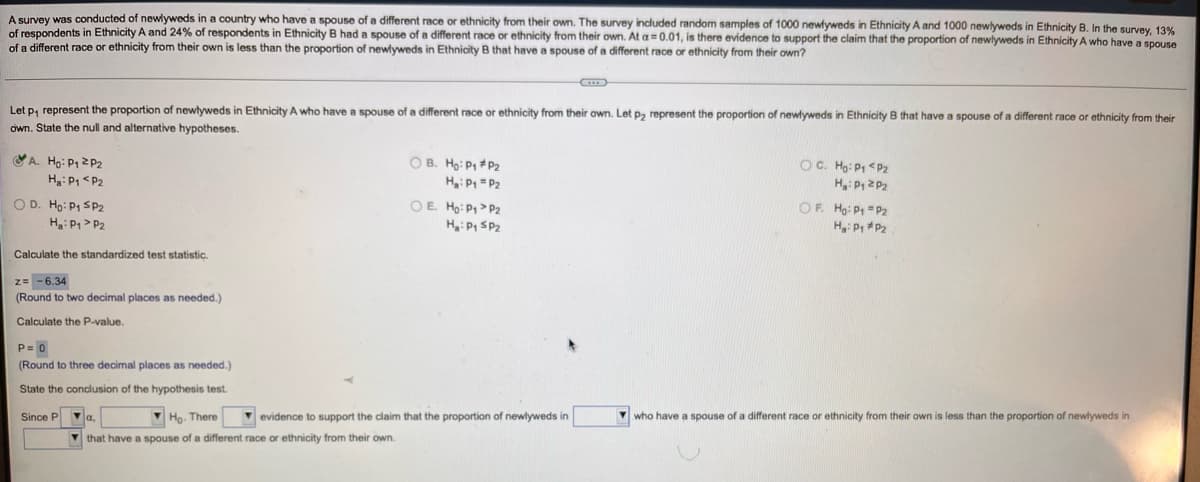A Survey was conducted of newlyweds in a country who have a spouse of a different race or ethnicity from their own. The survey included random samples of 1000 newlyweds in Ethnicity A and 1000 newlyweds in Ethnicity B. In the survey, 13% of respondents in Ethnicity A and 24% of respondents in Ethnicity B had a spouse of a different race or ethnicity from their own. At a=0.01, is there evidence to support the claim that the proportion of newlyweds in Ethnicity A who have a spouse of a different race or ethnicity from their own is less than the proportion of newlyweds in Ethnicity B that have a spouse of a different race or ethnicity from their own? Let p, represent the proportion of newlyweds in Ethnicity A who have a spouse of a different race or ethnicity from their own. Let p, represent the proportion of newlyweds in Ethnicity B that have a spouse of a different race or ethnicity from their own. State the null and alternative hypotheses. A. Ho: P12 P2 H: P P2 H: P SP2 Calculate the standardized test statistic. z= -6.34 (Round to two decimal places as needed.) Calculate the P-value. P=0 (Round to three decimal places as needed.) State the conclusion of the hypothesis test Since P a, V Họ. There evidence to support the claim that the proportion of newlyweds in who have a spouse of a different race or ethnicity from their own is less than the proportion of newlyweds in Y that have a spouse of a different race or ethnicity from their own.
A Survey was conducted of newlyweds in a country who have a spouse of a different race or ethnicity from their own. The survey included random samples of 1000 newlyweds in Ethnicity A and 1000 newlyweds in Ethnicity B. In the survey, 13% of respondents in Ethnicity A and 24% of respondents in Ethnicity B had a spouse of a different race or ethnicity from their own. At a=0.01, is there evidence to support the claim that the proportion of newlyweds in Ethnicity A who have a spouse of a different race or ethnicity from their own is less than the proportion of newlyweds in Ethnicity B that have a spouse of a different race or ethnicity from their own? Let p, represent the proportion of newlyweds in Ethnicity A who have a spouse of a different race or ethnicity from their own. Let p, represent the proportion of newlyweds in Ethnicity B that have a spouse of a different race or ethnicity from their own. State the null and alternative hypotheses. A. Ho: P12 P2 H: P P2 H: P SP2 Calculate the standardized test statistic. z= -6.34 (Round to two decimal places as needed.) Calculate the P-value. P=0 (Round to three decimal places as needed.) State the conclusion of the hypothesis test Since P a, V Họ. There evidence to support the claim that the proportion of newlyweds in who have a spouse of a different race or ethnicity from their own is less than the proportion of newlyweds in Y that have a spouse of a different race or ethnicity from their own.
Holt Mcdougal Larson Pre-algebra: Student Edition 2012
1st Edition
ISBN:9780547587776
Author:HOLT MCDOUGAL
Publisher:HOLT MCDOUGAL
Chapter11: Data Analysis And Probability
Section: Chapter Questions
Problem 8CR
Related questions
Question

Transcribed Image Text:A Survey was conducted of newlyweds in a country who have a spouse of a different race or ethnicity from their own. The survey included random samples of 1000 newtyweds in Ethnicity A and 1000 newlyweds in Ethnicity B. In the survey, 13%
of respondents
of a different race or ethnicity from their own is less than the proportion of newlyweds in Ethnicity B that have a spouse of a different race or ethnicity from their own?
Ethnicity A and 24% of respondents in Ethnicity B had a spouse of a different race or ethnicity from their own. At a = 0.01, is there evidence to support the claim that the proportion of newlyweds in Ethnicity A who have a spouse
Let p, represent the proportion of newlyweds in Ethnicity A who have a spouse of a different race or ethnicity from their own. Let p, represent the proportion of newlyweds in Ethnicity B that have a spouse of a different race or ethnicity from their
own. State the null and alternative hypotheses.
YA. Ho: P1 Z P2
Hg: P1 <P2
O B. Ho: P *P2
H: P =P2
OC. Hg: P <P2
H: P 2P2
O D. Ho: P1 SP2
OE Ho: P > P2
OF. Ho: P =P2
H, P P2
H: P1 > P2
H: P SP2
Calculate the standardized test statistic.
z= -6.34
(Round to two decimal places as needed.)
Calculate the P.value.
P= 0
(Round to three decimal places as needed.)
State the conclusion of the hypothesis test.
Since P
V Ho. There
V evidence to support the claim that the proportion of newlyweds in
V who have a spouse of a different race or ethnicity from their own is less than the proportion of newlyweds in
that have a spouse of a different race or ethnicity from their own.
Expert Solution
This question has been solved!
Explore an expertly crafted, step-by-step solution for a thorough understanding of key concepts.
This is a popular solution!
Trending now
This is a popular solution!
Step by step
Solved in 4 steps with 4 images

Recommended textbooks for you

Holt Mcdougal Larson Pre-algebra: Student Edition…
Algebra
ISBN:
9780547587776
Author:
HOLT MCDOUGAL
Publisher:
HOLT MCDOUGAL

Algebra & Trigonometry with Analytic Geometry
Algebra
ISBN:
9781133382119
Author:
Swokowski
Publisher:
Cengage

Holt Mcdougal Larson Pre-algebra: Student Edition…
Algebra
ISBN:
9780547587776
Author:
HOLT MCDOUGAL
Publisher:
HOLT MCDOUGAL

Algebra & Trigonometry with Analytic Geometry
Algebra
ISBN:
9781133382119
Author:
Swokowski
Publisher:
Cengage